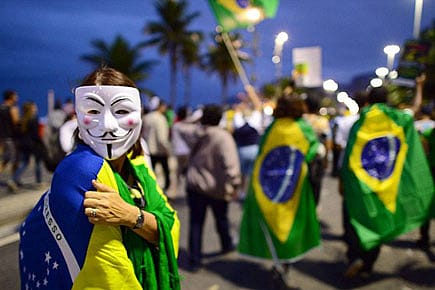The Other Side of Brazil

What the country's recent football glories conceal
More used to euphoric street celebrations following football excellence, the Brazil of recent protests during this year's Confederation Cup shows its government and the world that, far from being a tropical utopia, the country is in turmoil. What started as a localised movement for free public transportation quickly moved to encompass broader national demands against corruption, rising inflation and better use of public money—as in more public schools and hospitals instead of fancy football stadiums for next year's World Cup.
The grievances of this troubled Brazil have a long shadow. In my case, it started from day one.
Thirty-one years ago, I was born inside an ill-equipped public hospital in the state of São Paulo and struggled, after a premature birth, against the odds of a badly managed incubator and improper medical supervision. The miracle of birth in my case turned out to be a miracle of survival. With luck, I made it out alive, but was unlucky enough to become legally blind. Perhaps it was one of those purposeful misfortunes in life that serve as a perpetual reminder of the Brazil that is being targeted in the recent protests—an unjust and negligent one of health centres that let the sick die in its corridors, public schools with missing teachers, cities without sewage, streets without safety and corruption without end.
Growing up, I commuted long distances in crowded public buses to go to school and came home at sunset generally afraid of being robbed. Strikes were frequent. Price hikes even more. Inflation was a concept that I understood in the process of buying candies at different hours of the day.
While hyperinflation has been tamed, poor social services have endured, despite the rhetoric of development, social pacts, promises of inclusion and some concrete action by recent governments to promote better redistribution through conditional cash transfer programmes. Those at the very bottom are indeed seeing some benefits through socio-economic assistance and political attention. It is the middle-class that feels left behind. They fear the persistence of old injustices and take issue with the government's plastic smiles during international sporting events. The protest messages, often written in English, are for both domestic and international audiences.
Among their many demands, the one for better schools has echoed throughout the country. While enrolment rates have gone up, what worries the middle-class is the systematic neglect of public schools in relation to the quality of education. My long daily commute to school was precisely for that—to bridge the quality gap separating my house and a decent centre for learning located many kilometres away.
The history of poor educational opportunities and outcomes in the country goes back several centuries. Colonial Brazil did not see a printing press until the 19th century and colleges were scarce even for the elite. Following independence, an elitist system was established, not dissimilar to the educational reality of post-independent India, another BRIC country struggling to promote general social wellbeing—another country, too, that favoured tertiary education for the few at the expense of basic schooling for the masses.
While many of the top universities in Brazil are public such as University of São Paulo (USP), State University of Campinas (Unicamp) and Federal University in Rio de Janeiro , students who gain admission come mostly from private schools or from extra-curricular—and often very pricey—preparatory classes for university entrance exams known in the country as 'vestibular'. Adding to the challenge, the average record of scholastic performance of Brazilian children leaves a lot to be desired in both global and regional comparisons. According to the triennial OECD's Program for International Student Assessment (PISA) given to 15-year-old students, Brazil ranked 53rd in reading proficiency and 57th in math and science among 65 countries, behind other large Latin American countries such as Argentina and Mexico. Much has been said about the role of social networks as a key organisational tool during recent protests. Not much is remembered of the speed with which Brazilian youth have organised themselves on the streets in previous mass protests.
When I was 10, right outside my school, I recall seeing the outcry of the 'movimento caras-pintadas' ('painted-faces movement'), marching loudly and in big numbers in the wake of corruption allegations that led to the resignation and impeachment of former president Fernando Collor de Mello in 1992. At that time, student organisations such as the União Nacional dos Estudantes (UNE ) and União Brasileira dos Estudantes Secundaristas (UBES), pioneers in their call for free public transportation, led intense demonstrations demanding Collor's removal. Collor ultimately resigned and was later impeached by the Senate and disqualified to hold a public office for the next eight years. If my first real-life economics lesson was on inflation, the first one in politics was on impeachment.
Almost 20 years later, the consolidated maturity of Brazil's democracy finds expression in the very manner in which the growing middle-class channels its dissatisfaction. Tired of being forgotten in the middle of a stack of different classes and a big pile of priorities that excluded theirs, those on the streets show those outside the country that, other than in the enchanting footwork of football and samba, their feet are also capable of serving Brazilians up in protest at a time when all eyes are on them.
Sergio Mukherjee is a doctoral candidate in political science at University of Pennsylvania. His research focuses on the policies and politics of basic education provision in Brazil and India. He is a Brazilian of Indian origin. He was born in a public hospital in the state of Sao Paulo. After a premature birth, he was kept in an incubator to receive ultra-violet (UV) light therapy without being blindfolded. His hospital left him legally blind
